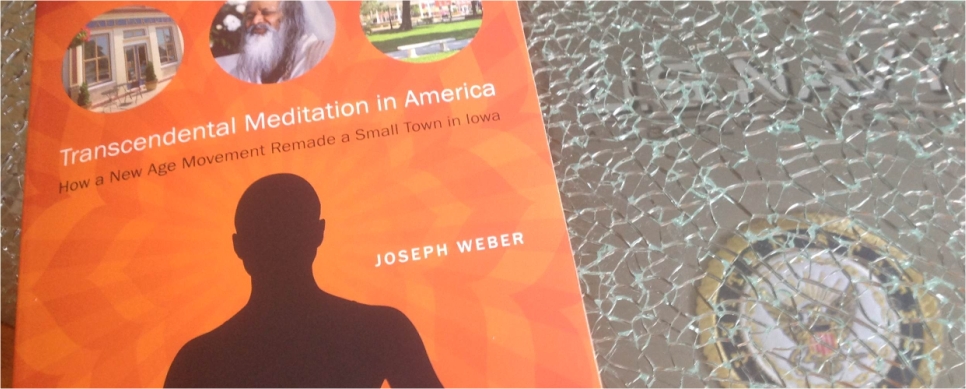The Transcendental Meditation instruction ritual, the puja, establishes for new meditators the dominance and authority of TM’s founding tradition and organization, and satisfies a traditional religious belief that the benefits of TM will only come by way of a tangible offering made to the primary, supreme divine beings of Hinduism. In an effort to maintain an illusory image of TM in which it’s a scientific, evidence-based practice having no religious foundation, TM teachers always misrepresent the purpose and nature of this aspect of TM. They deny this ritual’s religious origin and nature, and it is in fact central to the teaching and practice of TM, and is much more than what they call it, “a simple thank-you ceremony.”
 |
| Camphor flame, part of the puja. Photo by the author. |
Instruction in the practice of Transcendental Meditation always involves the performance of a ritual, an expression of devotion that’s clearly of a religious nature. This puja is rooted in Hindu or Vedic spiritual practice, of the religious culture of India which is the source of everything associated with TM and its founder, Maharishi Mahesh Yogi. The presence of this puja as well as other religious aspects of TM, a religiosity that’s consistently denied by TM teachers and the organization, once resulted in an injunction prohibiting TM instruction in public schools in one region of the United States. A case currently active in Chicago seeks a similar outcome in the aftermath of a program that attempted to offer TM in public schools there.
Given the controversial nature of this ritual, TM teachers and promoters of Transcendental Meditation have always avoided describing it in any detail when discussing the process of teaching TM. They insist that TM is “not a religion” while the culture that surrounds TM and its teaching are saturated with a sanitized, irreligious at first glance, Hindu, or Vedic, doctrine. In a futile attempt to squelch free and public discussion of these aspects of TM instruction, TM teachers tell meditators not to discuss any aspects of personal instruction, including this ritual, with friends and family, while many of these details have been available online for almost three decades. A nondisclosure agreement has also been a part of TM instruction for many years.
Meanwhile, recent disclosures in the course of a lawsuit brought against the David Lynch Foundation (DLF) and other parties involved in an attempt to introduce the TM program in Chicago public schools indicate that that the DLF and the TM organization refused to teach TM without the inclusion of the puja when instructing public school students.
This insistence on inclusion of the puja ritual raises the question: if it’s just “a simple thank-you ceremony,” which is what prominent TM teacher Bob Roth calls it in his most recent TM promotional book, why is it so important to the DLF and the TM organization, that it always must be performed as part of each and every instance of TM instruction, in the presence of the prospective meditator? Supporters of TM have been known to ask exactly this question, assuming that were the puja to be omitted, TM’s popularity would be enhanced and a valid objection would be dealt with. There has never been, to my knowledge, a clear explanation addressing this matter provided by the organization.
In my opinion, there are two primary reasons for the presence of the puja.
-
The first apparent reason for a required puja is that it provides a certain experience to the new meditator that they will remember, intended to reinforce the supposedly life-changing benefits of the meditation itself. It also serves as a memorable point of transition, its intent being that an individual joins a worldwide movement, with a self-image more akin to that of a devotee receiving some allegedly precious esoteric knowledge than that of a customer who simply received meditation instruction. It is an expression of power, legitimacy and dominance of a religious tradition over the new meditator, and also serves as a reminder of that dominance and authority to the TM teacher.
-
The second apparent reason for a required puja addresses the religious beliefs and Hindu eschatology of the founder of TM and of others in the Hindu/Vedic tradition that was his point of origin. Some of those specific beliefs, as they relate to the function of the puja itself, are likely not known to many outside India or even among Western TM teachers. In short, as each offering made during the puja is connected to a specific, anticipated individual benefit of TM, they have evidently believed that the new meditator would not obtain the benefits of TM practice without a religious ritual in which offerings are made to the central supreme beings of that Vedic tradition. The puja is performed on behalf of the meditator with fruit, flowers and white cloth that he or she brings with them to instruction; the meditator is required to actively contribute to the offerings used in the ritual and is thus not merely a bystander unconnected with, or simply witnessing, its performance.
SOURCE: tmfree.blogspot.com
Introduction: Demystifying the Puja, a 3 part series” target=”_blank”>”Introduction: Demystifying the Puja, a 3 part series”







